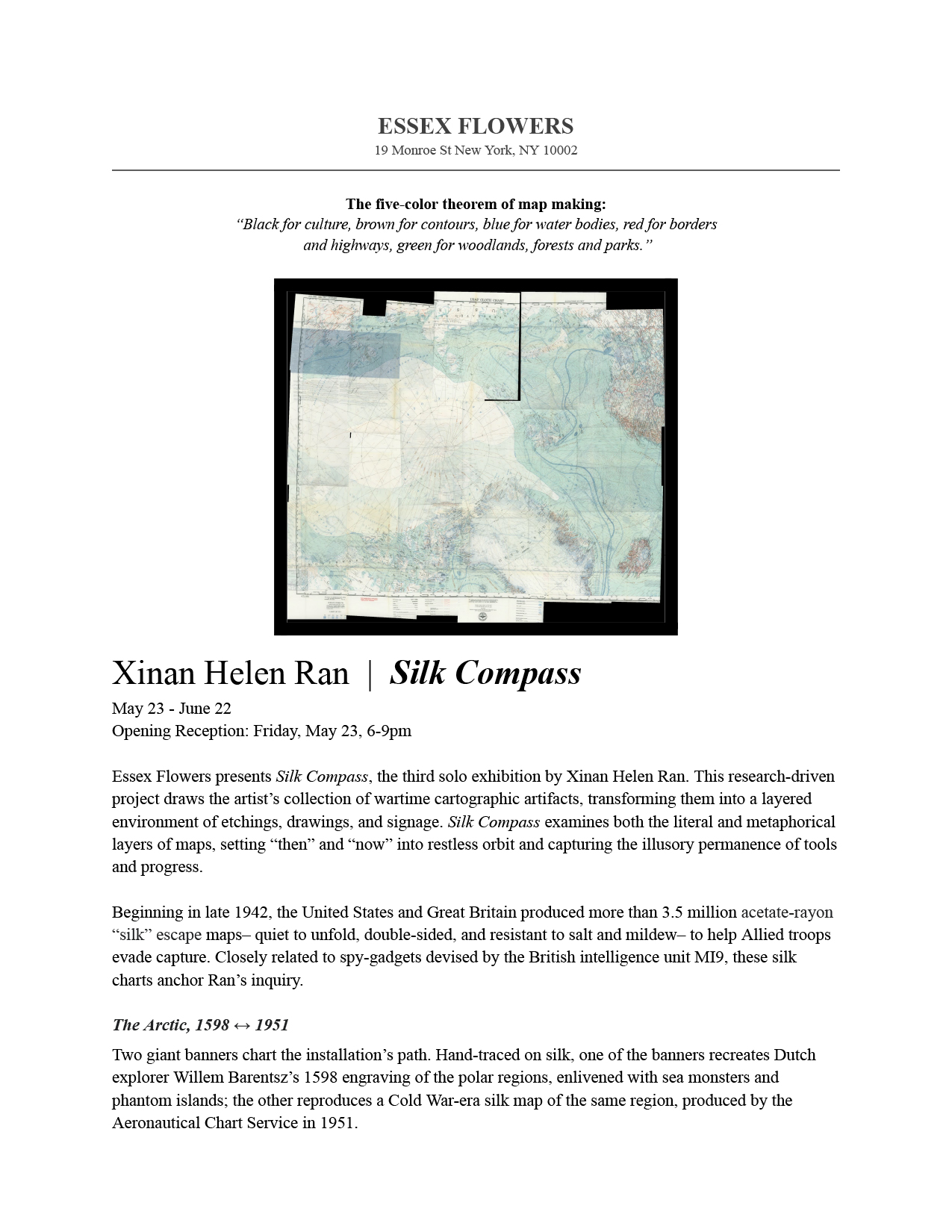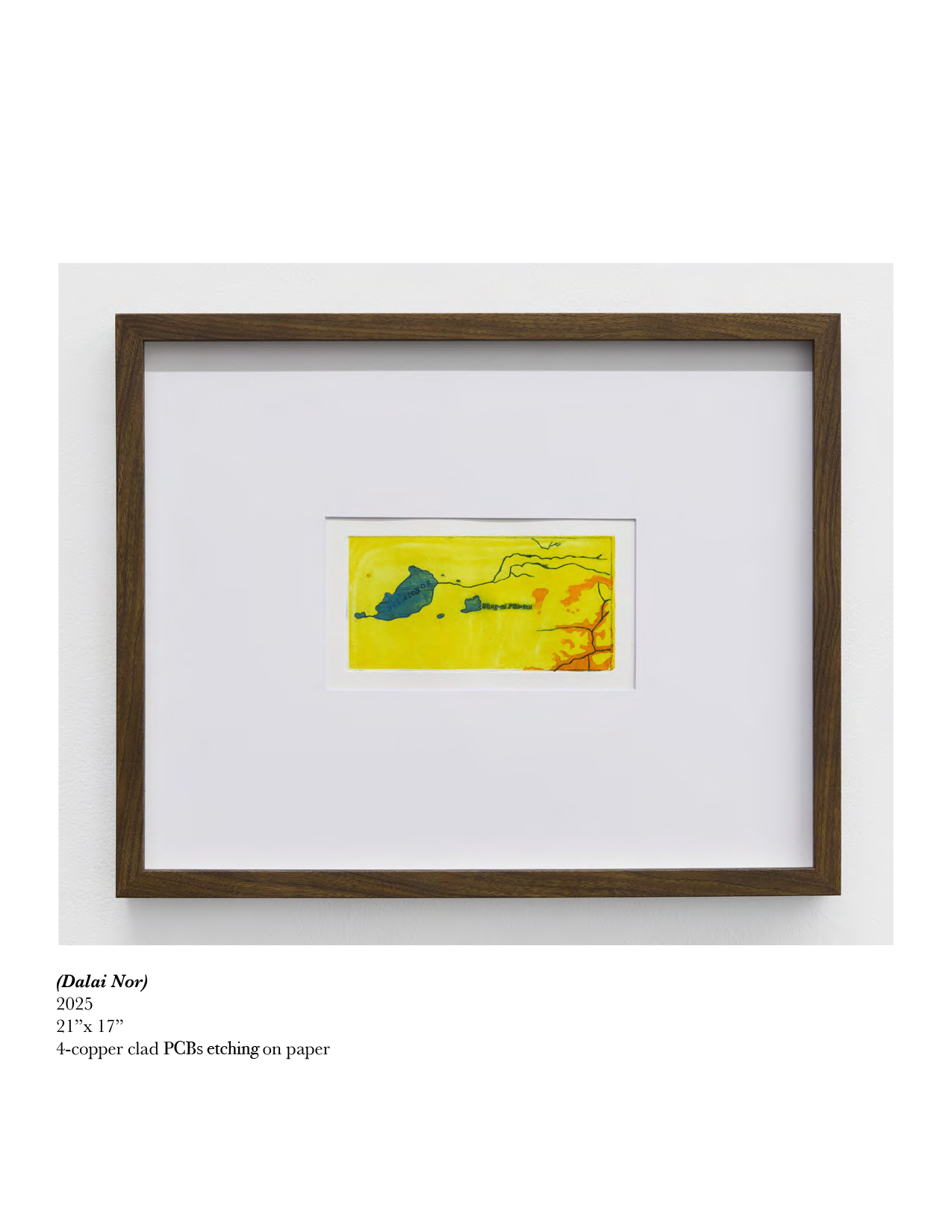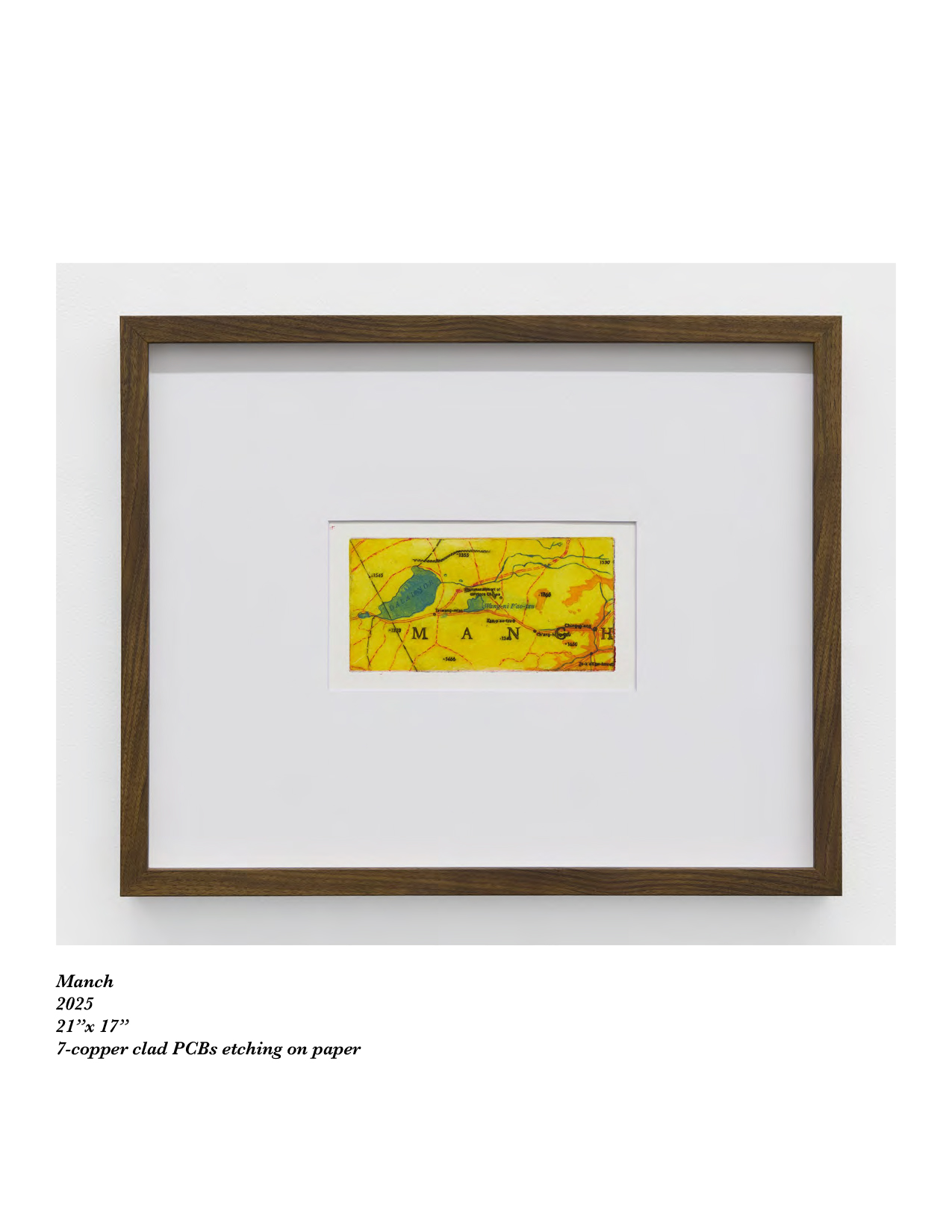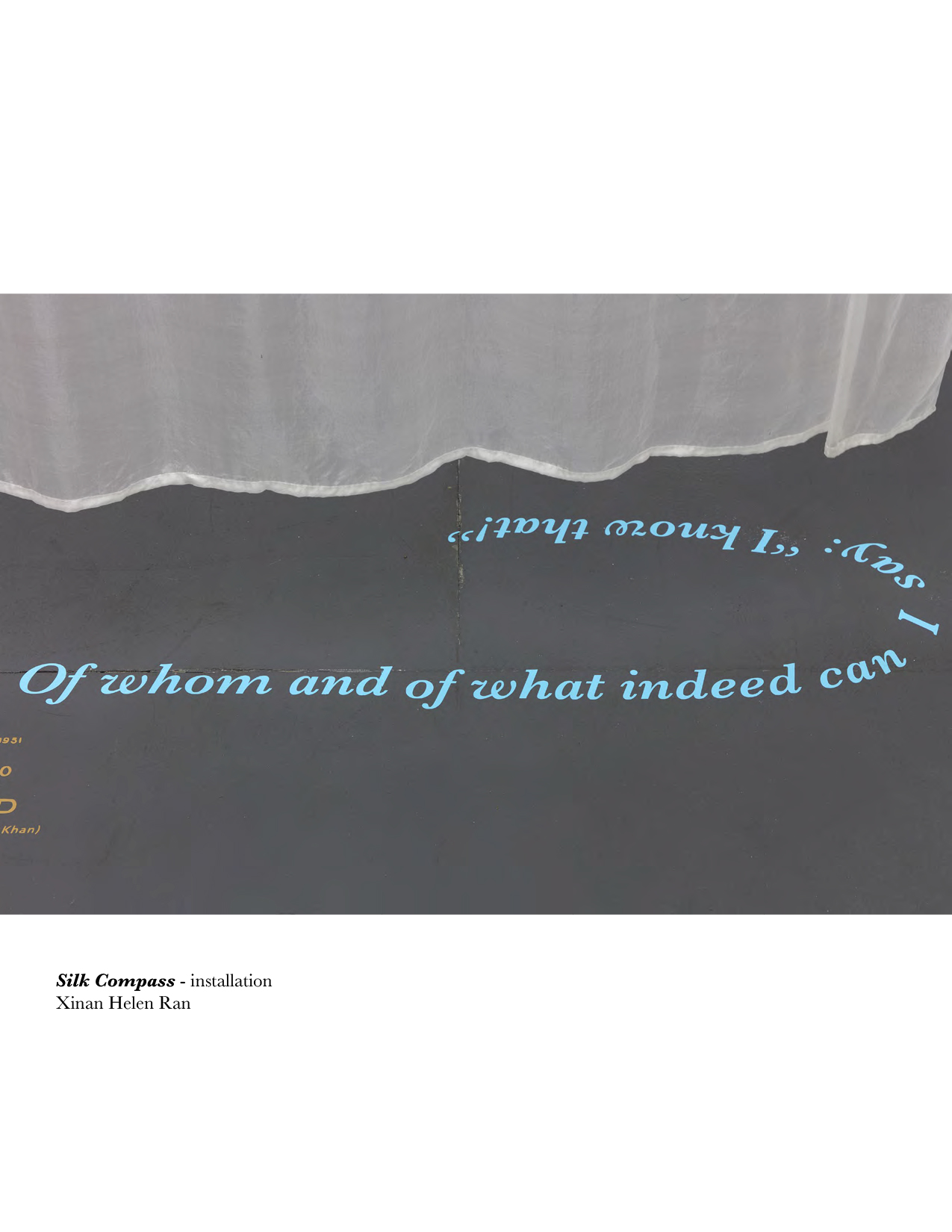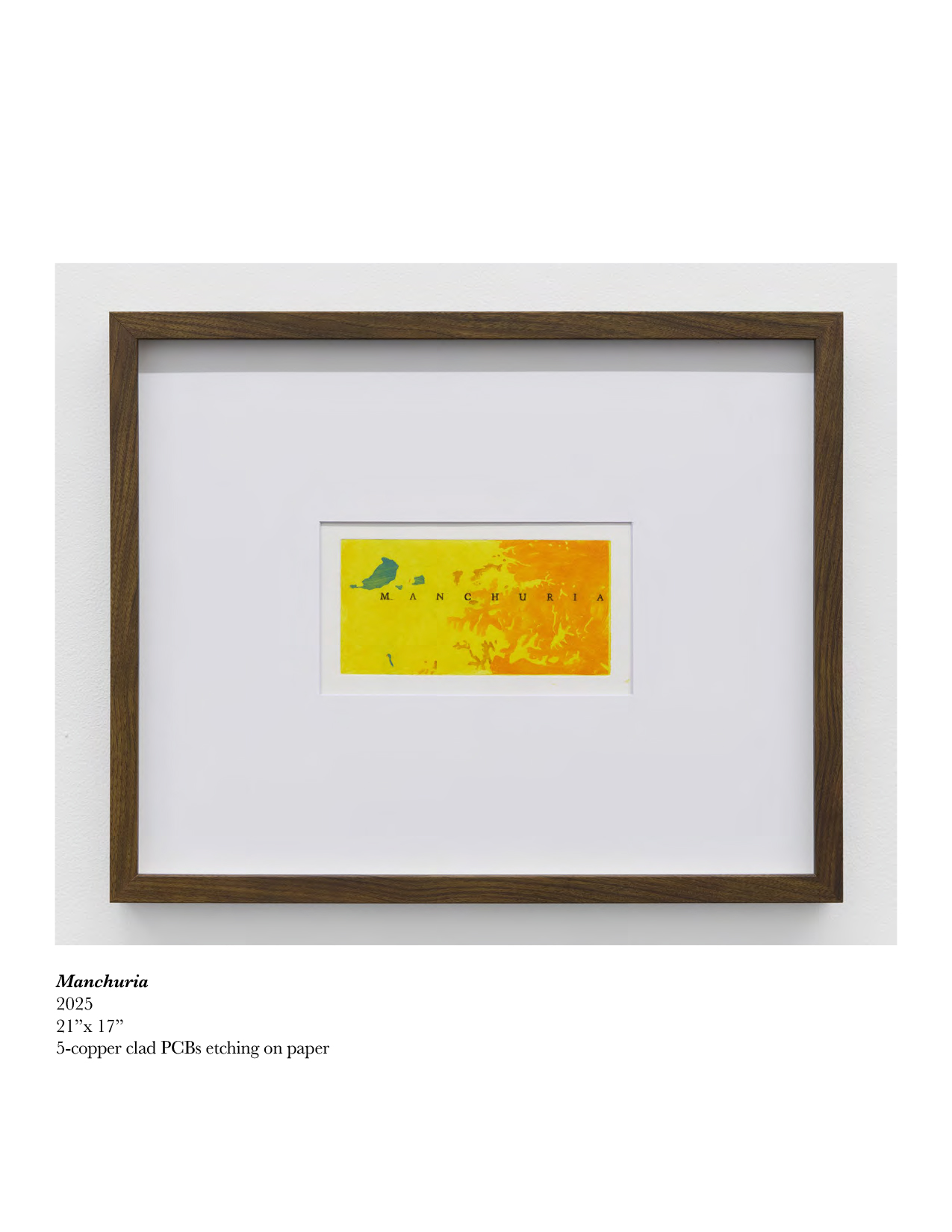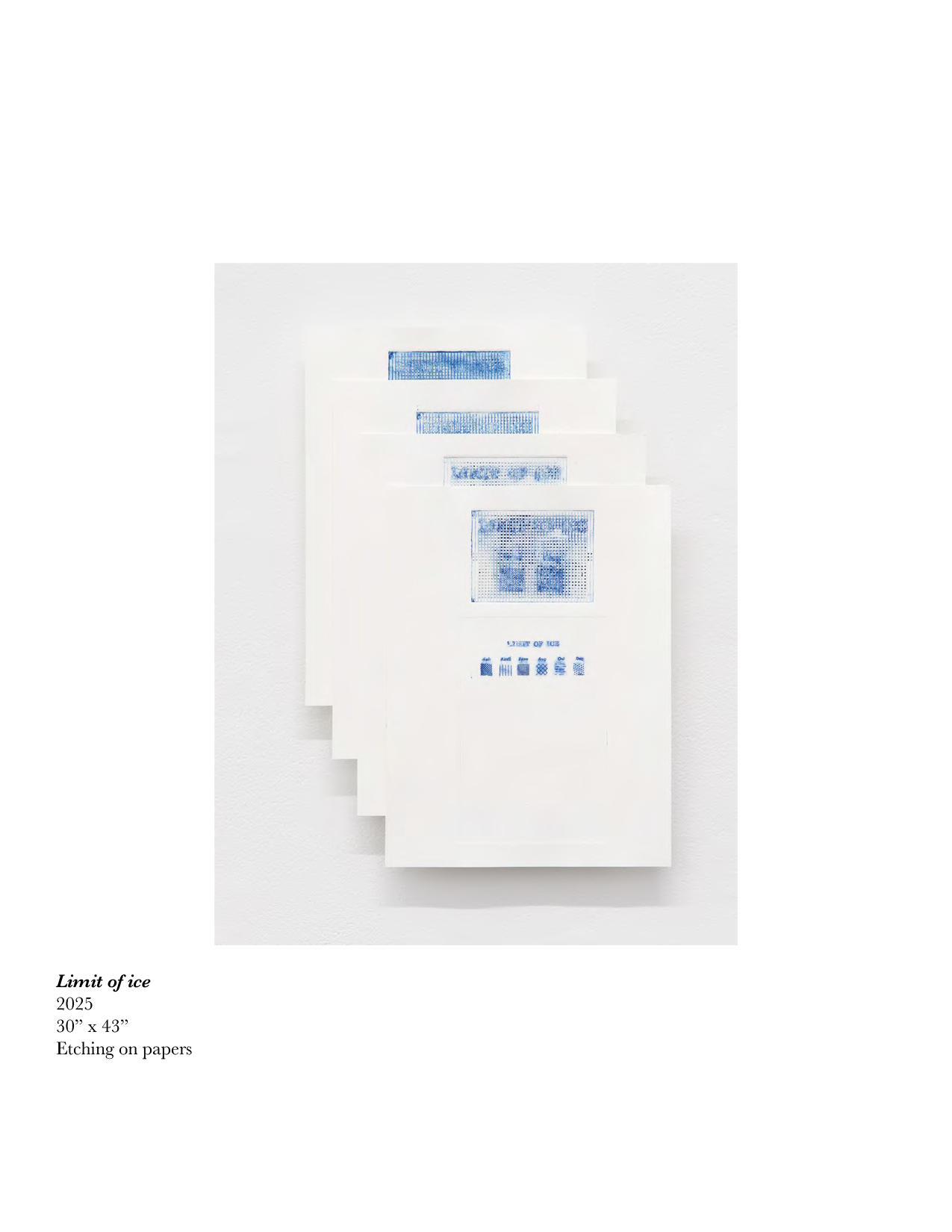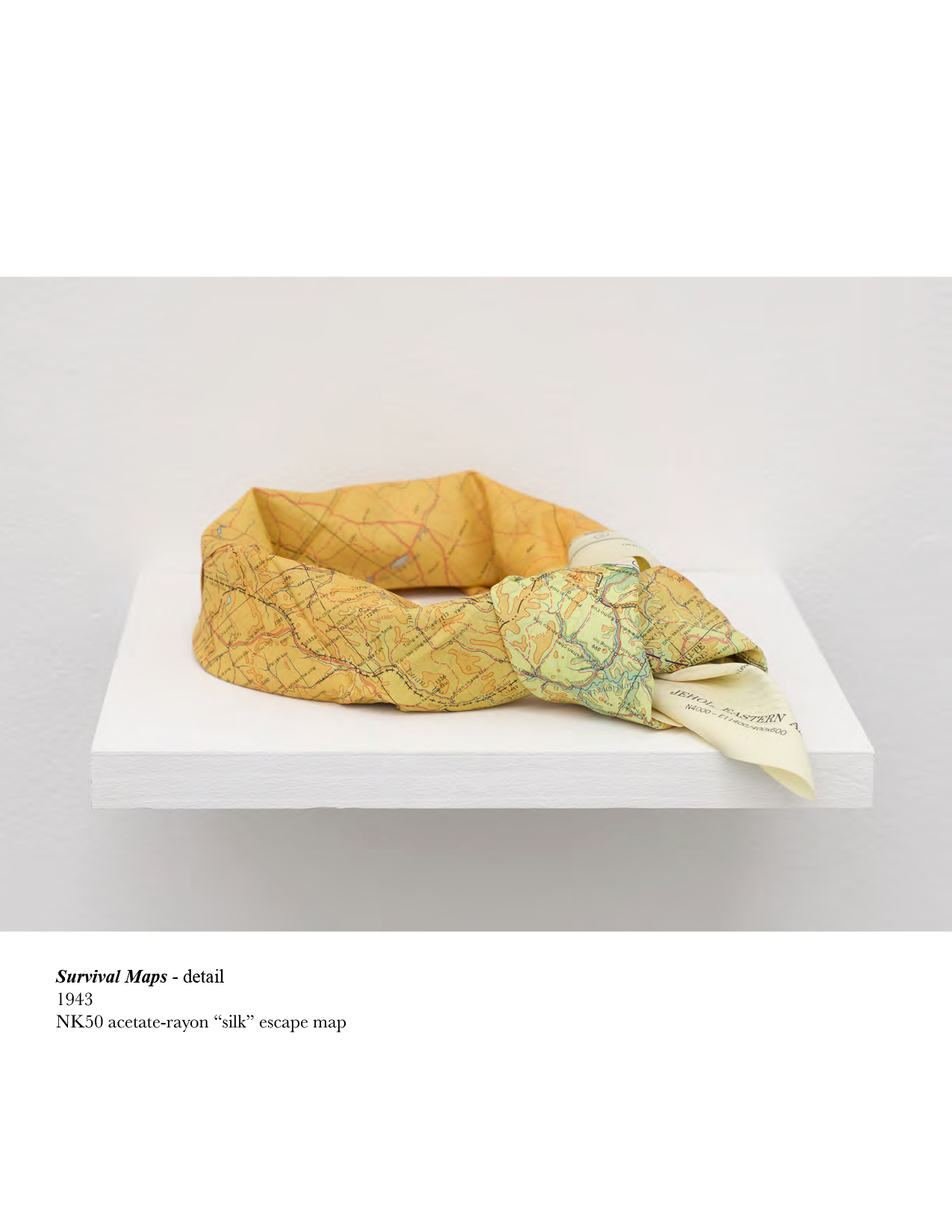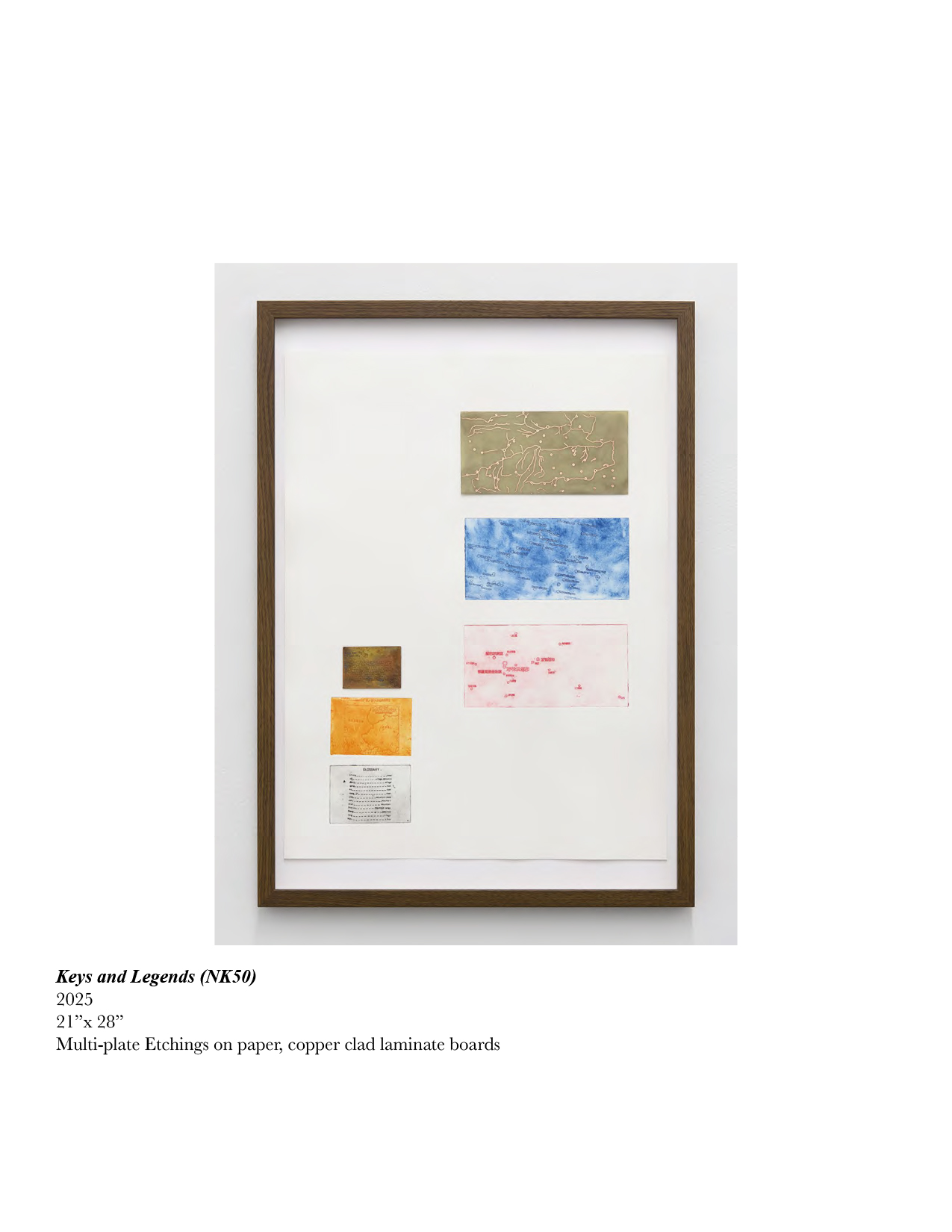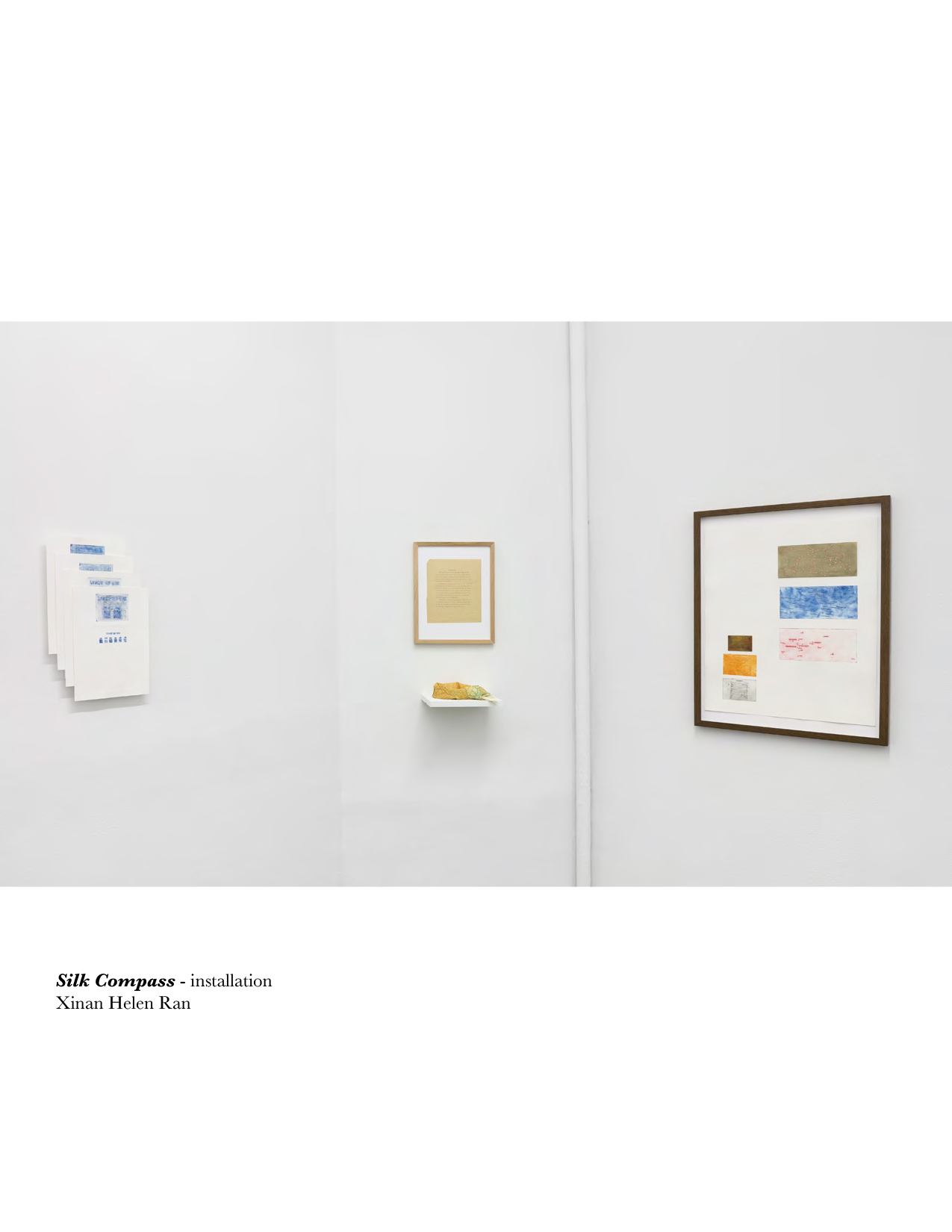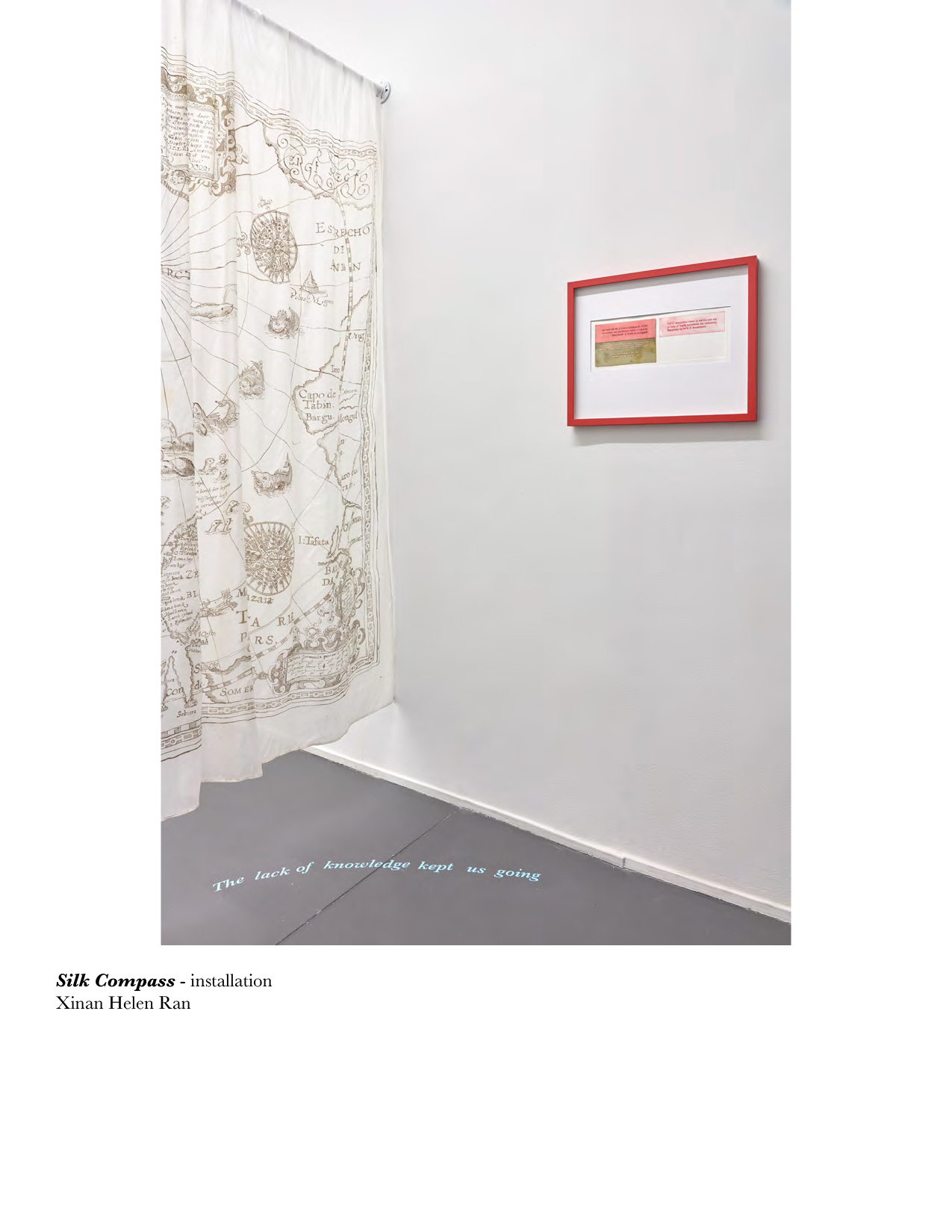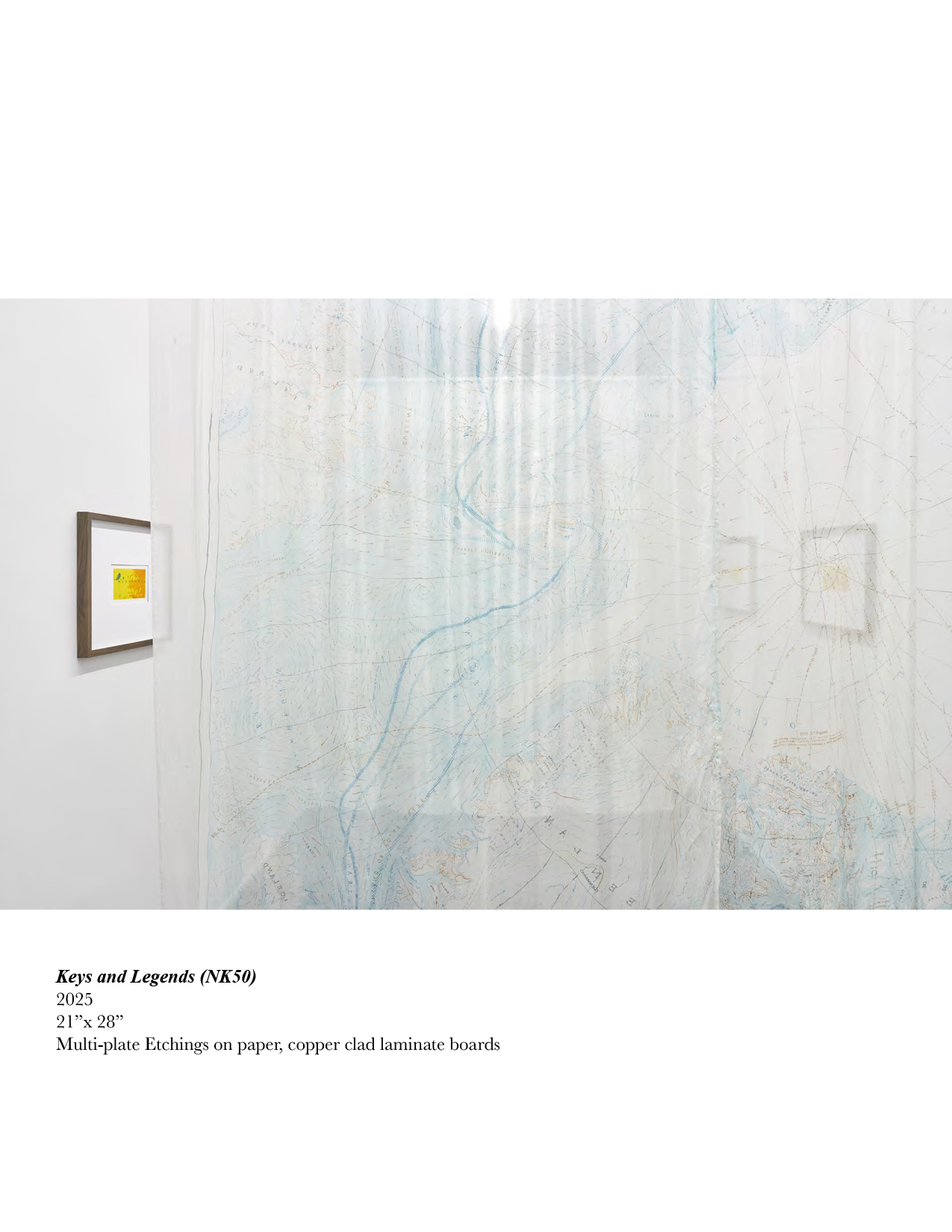XINAN HELEN RAN
Silk CompassMay 23 - June 22, 2025
Opening Reception: Friday, May 23, 6-9pm
The five-color theorem of map making:
“Black for culture, brown for contours, blue for water bodies, red for borders
and highways, green for woodlands, forests and parks.”

Essex Flowers presents Silk Compass, the third solo exhibition by Xinan Helen Ran. This research-driven project draws the artist’s collection of wartime cartographic artifacts, transforming them into a layered environment of etchings, drawings, and signage. Silk Compass examines both the literal and metaphorical layers of maps, setting “then” and “now” into restless orbit and capturing the illusory permanence of tools and progress.
Beginning in late 1942, the United States and Great Britain produced more than 3.5 million acetate-rayon “silk” escape maps– quiet to unfold, double-sided, and resistant to salt and mildew– to help Allied troops evade capture. Closely related to spy-gadgets devised by the British intelligence unit MI9, these silk charts anchor Ran’s inquiry.
The Arctic, 1598 ↔ 1951
Two giant banners chart the installation’s path. Hand-traced on silk, one of the banners recreates Dutch explorer Willem Barentsz’s 1598 engraving of the polar regions, enlivened with sea monsters and phantom islands; the other reproduces a Cold War-era silk map of the same region, produced by the Aeronautical Chart Service in 1951.
The pair– each designed for survival and secrecy– shows how a landscape shifts from Renaissance myth to Cold War battleground. Yet both reveal the same illusions: the limits of knowledge, the permanence of borders, and our supposed mastery over nature. Even the more sophisticated army Arctic map proves to be a fable; now with global warming rearranging the “permanent” ice cap faster than regimes can redraw borders.
Manchuria, 1943 ↔ 2025
A second dialogue between WWII and the present unfolds in a trio of etchings derived from a 1944 silk map of Manchuria, then a puppet state under Imperial Japan. Printed on copper-clad circuit boards (PCB), the works enlarge the Da Hinggan Ling region– Ran’s birthplace. For each finished piece, she overprints up to seven PCB plates, fusing the logics of traditional printmaking and circuit fabrication. As viewers progress through the sequence, the vision gradually clarifies; only the final print fully spells “Manchuria.” This measured reveal echoes Ran’s own first encounter with the map: caught between awe and bewilderment as she held this eBay find in her Brooklyn Apartment.
As she examined the map, a new question surfaced: if survival hinges on orientation, what happens when the map itself lacks credibility? A note in the bottom-left corner identifies this NK50 chart as a patchwork of four Soviet, Chinese and British sources. Place-names shift among Chinese, Mongolian, Japanese, and Russian transliterations, while clashing projections distort distance. Furthermore, constrained by its very medium, the fabric map cannot convey the immaterial fault lines of culture, allegiance, identity and power that layer a war zone– imperceptible to the pilots flying above, for whom these maps were their “last hope” of safe return.
Folded like a kerchief, the original Manchurian silk map rests in the back of the space. After the war, it was anecdotally handed out as a souvenir at the hotel Shangri-La in Santa Monica– the only Shangri-La chain in the US– likely in the 1970s. The accompanying note further romanticized the not-so-distant past of wartime survival.
Maps were, and will never cease to be, attempts to completely experience reality. As physical charts yield to algorithmic ones, and personal data constructs new frontiers, maps harbor and extend fictions, biases– “paper towns”. How, then, do we safely escape and find our way home, my comrades?
//
Xinan Helen Ran (b. 1994. Inner Mongolia, China) creates scalable installations, searching for the point where trauma, nihilism, and humor converge. Ranked “Highbrow and Brilliant” by the New York Magazine Matrix, Xinan is a 2025 MacDowell Fellow, a 2024 More Art Commission Artist, a 2024 New York State Council on the Arts grant recipient and has exhibited nationally and internationally. Xinan is an art educator, an art administrator, and an aspiring set designer for new theaters. www.xinanran.work
Beginning in late 1942, the United States and Great Britain produced more than 3.5 million acetate-rayon “silk” escape maps– quiet to unfold, double-sided, and resistant to salt and mildew– to help Allied troops evade capture. Closely related to spy-gadgets devised by the British intelligence unit MI9, these silk charts anchor Ran’s inquiry.
The Arctic, 1598 ↔ 1951
Two giant banners chart the installation’s path. Hand-traced on silk, one of the banners recreates Dutch explorer Willem Barentsz’s 1598 engraving of the polar regions, enlivened with sea monsters and phantom islands; the other reproduces a Cold War-era silk map of the same region, produced by the Aeronautical Chart Service in 1951.
The pair– each designed for survival and secrecy– shows how a landscape shifts from Renaissance myth to Cold War battleground. Yet both reveal the same illusions: the limits of knowledge, the permanence of borders, and our supposed mastery over nature. Even the more sophisticated army Arctic map proves to be a fable; now with global warming rearranging the “permanent” ice cap faster than regimes can redraw borders.
Manchuria, 1943 ↔ 2025
A second dialogue between WWII and the present unfolds in a trio of etchings derived from a 1944 silk map of Manchuria, then a puppet state under Imperial Japan. Printed on copper-clad circuit boards (PCB), the works enlarge the Da Hinggan Ling region– Ran’s birthplace. For each finished piece, she overprints up to seven PCB plates, fusing the logics of traditional printmaking and circuit fabrication. As viewers progress through the sequence, the vision gradually clarifies; only the final print fully spells “Manchuria.” This measured reveal echoes Ran’s own first encounter with the map: caught between awe and bewilderment as she held this eBay find in her Brooklyn Apartment.
As she examined the map, a new question surfaced: if survival hinges on orientation, what happens when the map itself lacks credibility? A note in the bottom-left corner identifies this NK50 chart as a patchwork of four Soviet, Chinese and British sources. Place-names shift among Chinese, Mongolian, Japanese, and Russian transliterations, while clashing projections distort distance. Furthermore, constrained by its very medium, the fabric map cannot convey the immaterial fault lines of culture, allegiance, identity and power that layer a war zone– imperceptible to the pilots flying above, for whom these maps were their “last hope” of safe return.
Folded like a kerchief, the original Manchurian silk map rests in the back of the space. After the war, it was anecdotally handed out as a souvenir at the hotel Shangri-La in Santa Monica– the only Shangri-La chain in the US– likely in the 1970s. The accompanying note further romanticized the not-so-distant past of wartime survival.
Maps were, and will never cease to be, attempts to completely experience reality. As physical charts yield to algorithmic ones, and personal data constructs new frontiers, maps harbor and extend fictions, biases– “paper towns”. How, then, do we safely escape and find our way home, my comrades?
//
Xinan Helen Ran (b. 1994. Inner Mongolia, China) creates scalable installations, searching for the point where trauma, nihilism, and humor converge. Ranked “Highbrow and Brilliant” by the New York Magazine Matrix, Xinan is a 2025 MacDowell Fellow, a 2024 More Art Commission Artist, a 2024 New York State Council on the Arts grant recipient and has exhibited nationally and internationally. Xinan is an art educator, an art administrator, and an aspiring set designer for new theaters. www.xinanran.work
Special thanks to MacDowell in Peterborough, NH,
all works in this exhibition were created there in Spring 2025
all works in this exhibition were created there in Spring 2025

Photo: Max C. Lee













